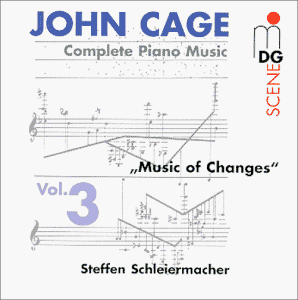The four parts of Cage’s Music of Changes (1951)
initiated a period in Cage’s output during which chance played a major
factor in the compositional process. Cage takes sixty-four hexagrams
from the I Ching as a generational force for the musical parameters
of pitch, duration, interval/aggregate and volume to generate four ‘Books’.
Music of Changes was the first work Cage wrote
for the pianist David Tudor. At the time Cage was in regular contact
with Pierre Boulez, and it is therefore possible Cage wanted to write
his own major piano work to complement the works being produced by the
serialists (Tudor had only recently given the American premiere of Boulez’
Second Piano Sonata).
The value of Schleiermacher’s Cage series is enormous.
For Music of Changes, in the interests of clarity, he has decided
to reduce Cage’s tempo markings by ‘a few degrees’, especially in Books
I and II. As he puts it, ‘This makes the piece longer but ... more transparent
and perhaps more interesting to listen to in detail’. Transparency and
clarity do indeed seem to be the watch-words of Schleiermacher’s playing,
along with positively quicksilver responses.
The First Part is the shortest (at 5’30) and has a
playful, capricious character. In contrast, the Second Part is 24’46
long and so has an opportunity to ‘stretch’ time: silences are, as so
often with Cage, integral to the musical argument. The longer the piece
is, the more opportunity there is to really enter in to the expanded
consciousness this music demands from the listener. The sparing inclusion
of the sound of plucked strings in the Second Part makes their arrival
particularly arresting musical events: there is a judicious use of ‘exteraneous’
noises in this interpretation.
The Third and Fourth Parts each last 11-12 minutes.
As with the music of Morton Feldman, when one has attuned to the listening
demands of this music and played the disc through, it seems the most
natural thing in the world to go back to the beginning and start again.
As Schleiermacher himself says in his introduction, ‘the work continues
to require a lot of nerve from the hearer and instrumentalist and to
offer them adventure’. It is certain that these demands Cage makes on
nerves and concentration yield many rewards.
Colin Clarke


